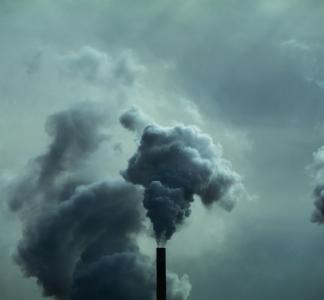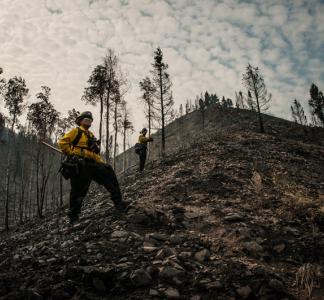Public land protections provide pathways to a successful Green New Deal

Pollution in the Santa Monica Mountains.
Kevin Dinkel, flickr.
Green New Deal aims to combat climate change and inequity
The Wilderness Society applauds Rep. Alexandria Ocasio-Cortez (D-NY) and Sen. Ed Markey (D-MA) for leading the Green New Deal resolution, and the 66 Representatives and 19 Senators who have already cosponsored.
The resolution lays out a framework for how to safeguard nature and humanity from the worst effects of climate change while providing sustainable economic opportunities, clean air and water and a just future for all. These goals can only be achieved if our 640 million acres of public lands are managed as part of the solution. We are excited by the opportunity to help achieve these goals.
Rep. Ocasio-Cortez referred to the resolution as a “Request for Proposals.” We look forward to collaborating with these leaders in Congress and partners to ensure that public lands play a role in equitable solutions.
Here’s how public lands can help achieve the Green New Deal five major goals:
Goal #1: Achieve net-zero greenhouse gas emissions through a fair and just transition for all communities and workers
Emissions from coal, oil and gas produced on public lands and waters make up nearly a quarter of all national emissions. Between 2005 and 2014, approximately 40% of coal, 26% of oil and 23% of natural gas developed in the U.S. came from public lands.
Of those emissions, only 15% were offset through sequestration on public lands, according to a recent report from the U.S. Geological Survey (USGS).
To reach or exceed net-zero greenhouse gas emissions, we must work to virtually eliminate existing emissions from energy development on public lands and work to sequester more carbon through reforestation and restoration of damaged lands.
Ensuring climate action creates jobs and helps communities transition away from fossil fuels is just as important as reducing emissions.
The communities most affected by pollution and boom-and-bust energy cycles should be supported to develop economic strategies to replace jobs and income lost to the inevitable decline in fossil fuel production. Public lands can play a major role by supporting sustainable economic alternatives, like renewable energy development and public lands recreation.
Goal #2: Create millions of good, high-wage jobs and ensure prosperity and economic security for all people of the United States
Protected public lands can attract investment and support jobs that promote restoration and access to nature including building trails, restoring wetlands and other wildlife habitat and improving facilities at our parks and monuments.
The outdoor recreation industry depends in part on protected public lands, with the industry’s economy directly supporting 7.6 million American jobs across the country.
In 2017, the outdoor recreation economy generated $887 billion in consumer spending, more than pharmaceuticals and fuel combined. More people participate in outdoor recreation each year (145 million) than attend NFL, NBA, and NHL games combined.
Research by Headwaters Economics has shown that the economic benefits of protected public lands extend beyond tourism. The value of these special places is their ability to attract and retain businesses, retirees and other people drawn to the higher quality of life.
Goal #3: Invest in the infrastructure and industry of the United States to sustainably meet the challenges of the 21st century
Our public lands can be a renewable energy powerhouse for the nation. The power potential of wind, solar and geothermal projects approved on public lands to date already exceeds the hydroelectric dams managed by the U.S. Bureau of Reclamation, which are capable of powering more than 4 million homes. But we have barely scratched the surface: less than 5% of the nation’s renewable power comes from public lands (compared to more than 40% of coal!).
Advancing renewable energy on public lands would create jobs and spur investment in a growing field. In 2016, solar employment grew 17 times faster than the U.S. economy. Solar alone now supports more jobs than the natural gas industry and twice the number of jobs as the coal industry.
We can and should build out large-scale renewable projects in the right places and the right ways to avoid unintended consequences to the natural world. We should give geothermal, wind and solar every advantage on public lands, including identifying areas not to develop with the most important wildlands and wildlife habitat, fairly pricing access and increasing the efficiency and predictability of permitting.
Goal #4. Secure clean air and water, climate and community resiliency, healthy food, access to nature and a sustainable environment for all people of the United States for generations to come
Public lands must be protected to maintain healthy ecosystems in the face of climate change. We must protect more of our forests, deserts and other wild places to increase carbon sequestration and ensure that these lands protect communities from intensifying storms and extreme weather events by being natural barriers.
Unfortunately drilling and mining continues to dominate on public lands with real consequences for communities. Oil, gas and coal development and combustion can harm water sources, human health, recreation and other purposes for which public lands were set aside and held in trust for the American people. We can reverse this trend by eliminating the subsidies and shortcuts that prop up coal, oil and gas producers and permit methane waste and other pollution.
Goal #5. Promote justice and equity by stopping current, preventing future, and repairing historic oppression of indigenous peoples, communities of color, migrant communities, deindustrialized communities, depopulated rural communities, the poor, low-income workers, women, the elderly, the unhoused, people with disabilities, and youth
Public lands belong to all of us equally regardless of race, income, or zip code but currently the brunt of the burden of air pollutants and climate change from public lands is not felt equitably. Often frontline communities, working class communities and communities of color bear the costs of pollution, low air quality, damage to public health, and the rising cost of extreme weather due to climate change.
This inequity demands us to fully consider and account for the negative cost of pollution from public lands, and ensure equity in access to decision making on how our lands are used. Front line communities traditionally left out of important decisions affecting their own well being should lead the way for developing just solutions for a new economy serving everyone in America.
Public lands are also an important proving ground for a respectful relationship with sovereign tribal nations. These public lands were in most cases taken from native peoples as our country expanded. The systematic disenfranchisement of land by the federal government has at times been perpetuated by the modern conservation system. Public lands management agencies must honor tribal sovereignty in their decision making and go beyond the legal requirement for consultation to partner with native nations in planning for the public lands systems to address climate change.
America’s system of public lands has been protected and set aside for the benefit of the American people. There is no greater benefit or need than sustaining life on the planet. FDR’s New Deal committed to building a just, sustainable and fair future for the people of America, a future we’ve all benefited from. The Green New Deal is a revival and renewal of that commitment, now updated and enhanced to address a global crisis.



